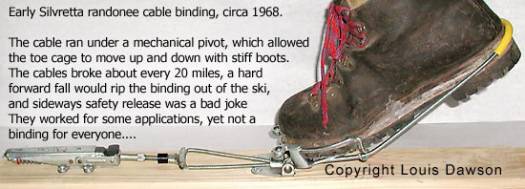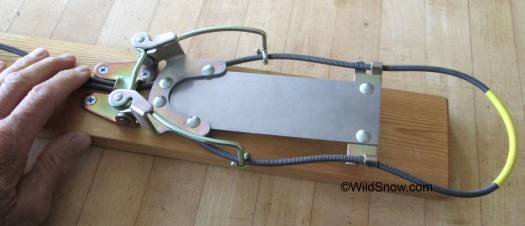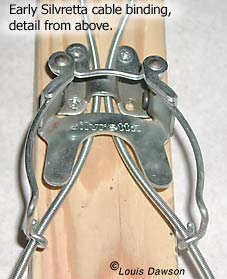Be sure to check out our ski touring binding museum.

Early Silvretta, 1960s, attempted to combine mechanical toe pivot with cable. This version was nearly unusable.
This first version of the Silvretta ski binding pictured above, circa 1960s, is an oddball in ski binding history. It worked poorly, and when I used it myself back in the early days I wondered how anyone could think up something so difficult to get properly functioning. For starters, it broke cables regularly due to the constant bending of the cables caused by the pivot, and extreme force place on the cables in a forward fall. More, it was difficult to screw the Saas Fee securely enough to wooden skis to prevent pulling out the screws when the binding was flexed forward. Adding to all that, the early version without a metal plate under your boot had such a problem with side slop of the boot heel as to be nearly dysfunctional.

Version of Saas Fee with stabilizer plate, this version was actually produced by Ramer Equipment for a military contract on in the 198s, but is nearly identical to earlier versions.
Soon after this original version of the Silvretta Saas Fee, in the early 1970s Silvretta added a stiff metal plate (sometimes known as a “bear paw” of “bear pad” ) under the boot, to prevent sideways slop.
We used this early version of a “plate” or “frame” binding to ski most of Denali in 1973. This plate, combined with the mechanical pivot, could perhaps be considered the first alpine touring randonnee plate “frame” binding.
As with other alpine skiing cable bindings, the Saas Fee was designed so you could latch the cable through sidewall lugs on your skis, thus latching down your boot heels. Our crew at the time tended to avoid this, as it totally locked out any sideways (lateral) safety release. Instead, we skied the binding as free-heel parallel. When set up correctly it worked okay. For example, on Denali in 1973, when we did the first repeat of Erling Strom’s ski of the Muldrow Glacier route, we used 180cm Miller Softs with the early Silvretta with bear paw plates. Combined with properly fitted leather double boots (Galibier Hivernal), the system worked for backcountry skiing, but was nothing like today’s randonnee AT gear.

1960s Silvretta binding toe detail.
The Silvretta Saas Fee was not for everyone. It was a highly specialized piece of machinery with a narrow range of purpose. When combined with the naiveté of most North American ski mountaineers of the time (compared to those in Europe), the result was frustration, and resulting experimentation with nordic equipment. Simply put, this version of the Silvretta binding may have been the seed of the telemark renovation we’ve seen over the last three decades. But equally as important, it was the foundation for the amazingly functional, durable, and lightweight randonee bindings we now enjoy.
Versions of the Silvretta Saas Fee were available on into the 1980s as it was manufactured under military contracts for use with arctic boots. It was sometimes called the NATO binding in those days. We do not know how long it was manufactured specifically by Silvretta, but probably into the mid 1970s.
Be sure to check out our ski touring binding museum.

Silvretta Saas Fe thumbnail.
WildSnow.com publisher emeritus and founder Lou (Louis Dawson) has a 50+ years career in climbing, backcountry skiing and ski mountaineering. He was the first person in history to ski down all 54 Colorado 14,000-foot peaks, has authored numerous books about about backcountry skiing, and has skied from the summit of Denali in Alaska, North America’s highest mountain.
